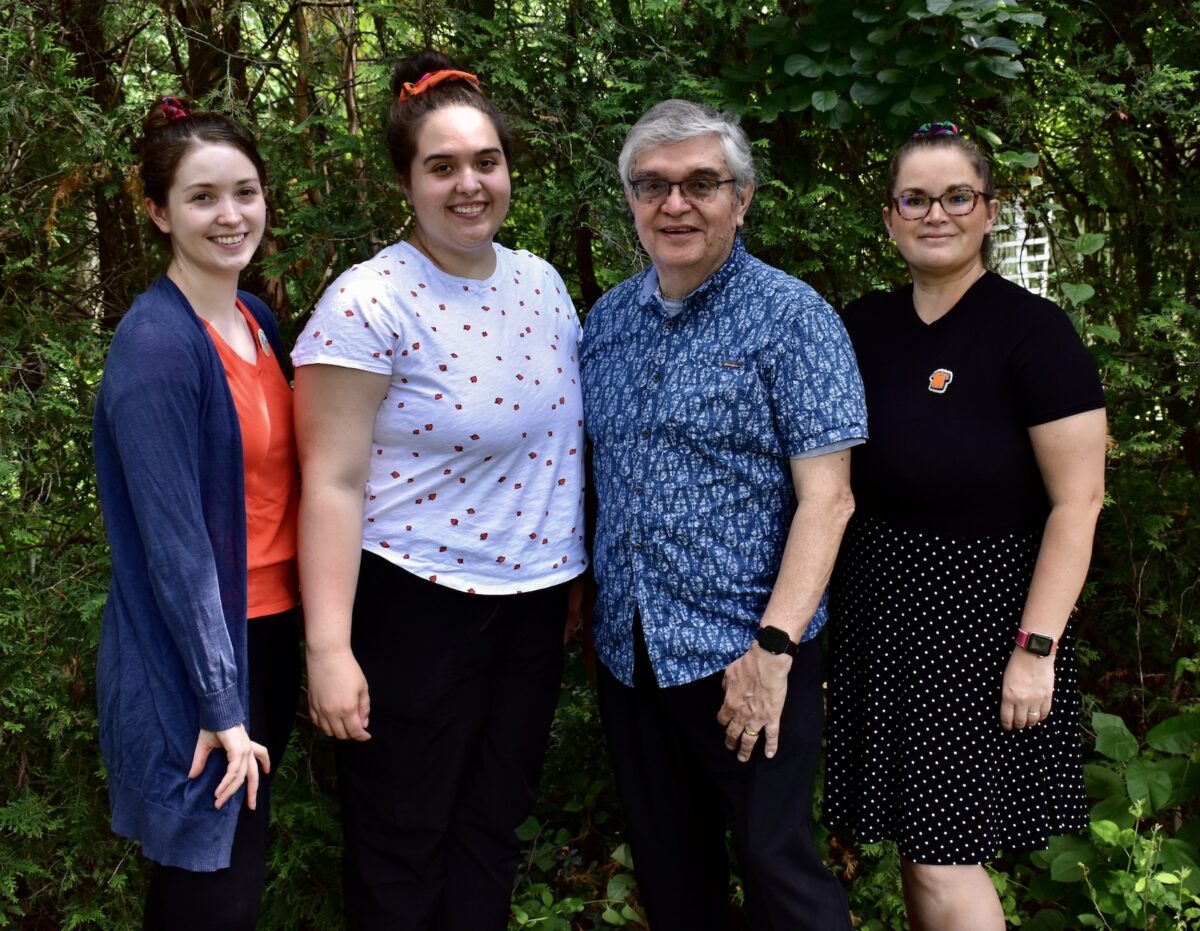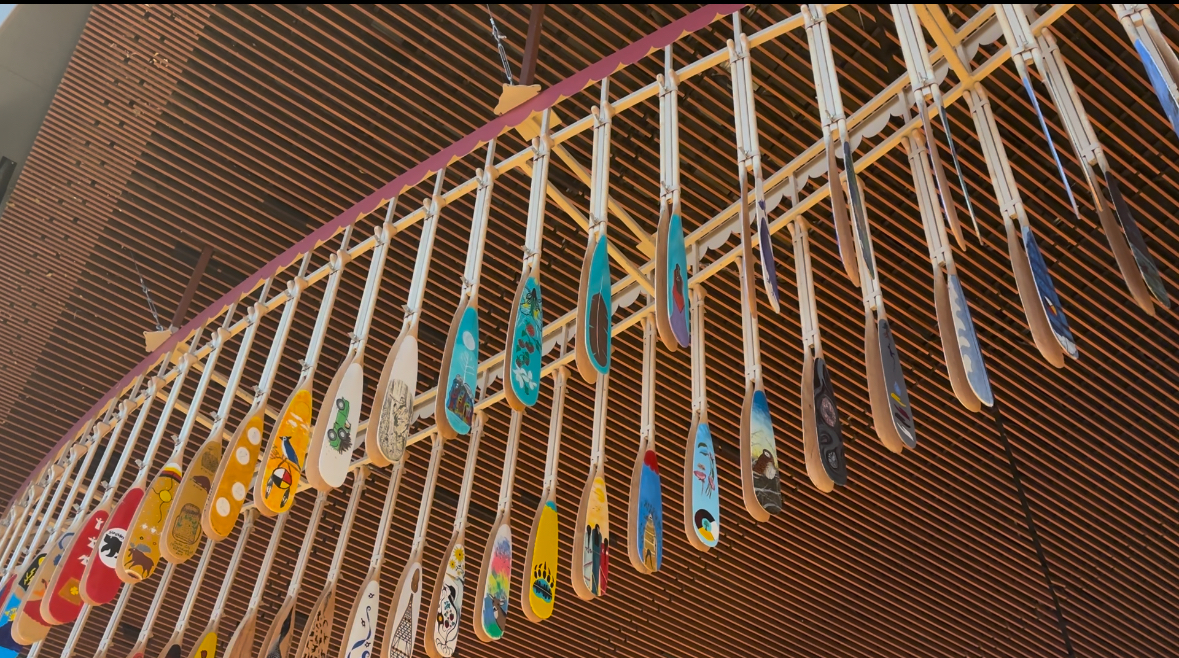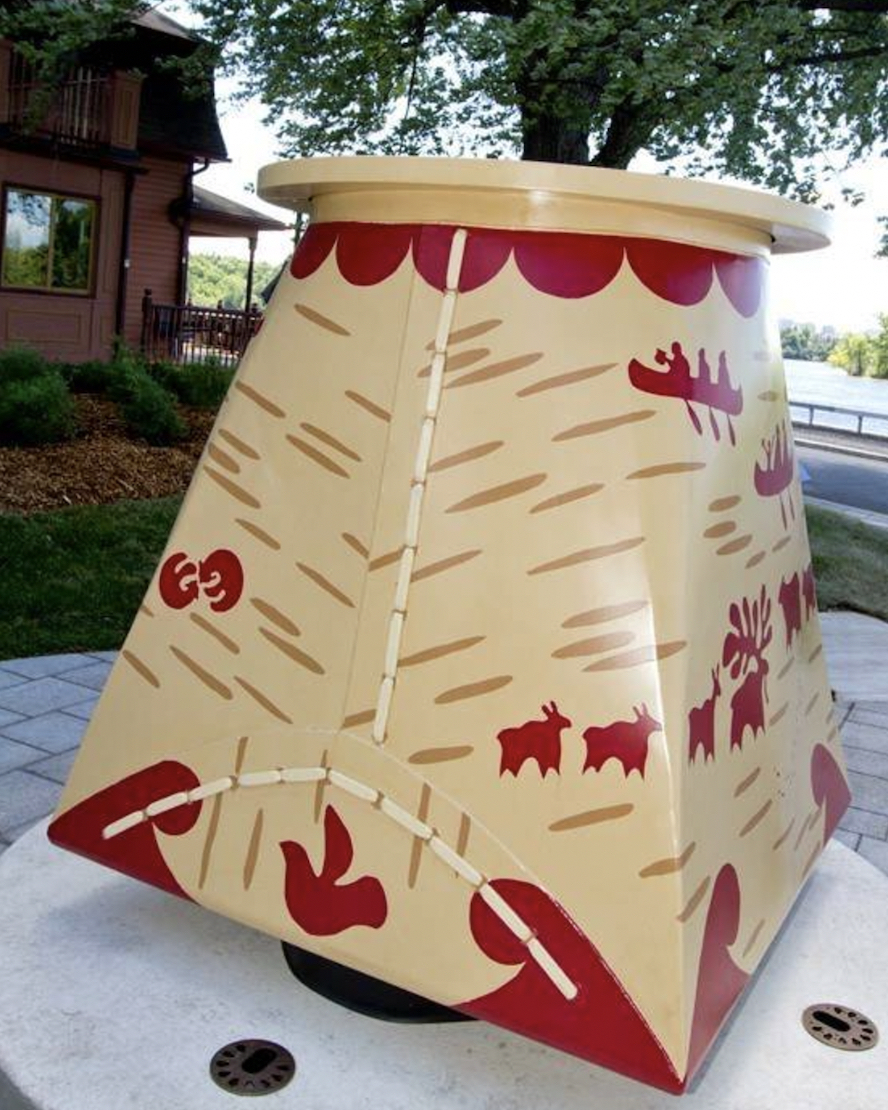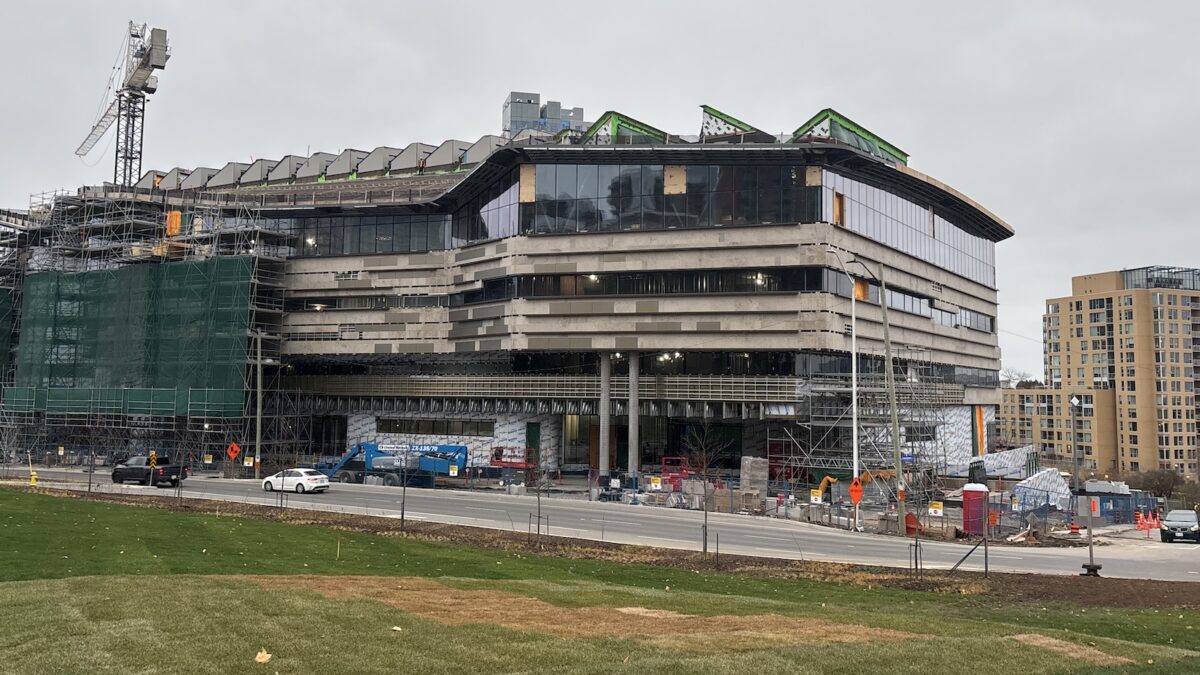As the days grow darker and the winter cold sets in across the capital, Emily Brascoupé-Hoefler is transported to the warmth of spring and a happy memory: family and friends picking the first fruits — what she calls “heart berries” — that burst through the earth every year on Algonquin land.
“We remember going out in Kitigan Zibi and picking tiny wild strawberries,” recalls Brascoupé-Hoefler, an Algonquin Anishinābe artist living in Ottawa but with roots in the Indigenous community near Maniwaki, Que.
Far from a distant memory, those “heart berries” from her childhood will soon be seen year-round at Ādisōke — the new downtown central library that will feature thousands of little strawberry window etchings created by Brascoupé-Hoefler and her sisters Mairi and Claire.
To Brascoupé-Hoefler, the designs are a perfect match for a place being built to celebrate storytelling — and to celebrate family and traditional Algonquin culture within its walls and through its windows.

Ādisōke means “storytelling” in the Anishinābemowin Algonquin language. Earlier this month, Ottawa’s new $334-million central library — a joint project of the Ottawa Public Library and Library and Archives Canada — hit a significant milestone. City council was informed in a staff update that “most of the windows have been installed, all of which include design elements from one of the Indigenous public art commissions for the facility.”
The windows will display the design created by the Brascoupé sisters through their art collective, along with many other visual elements tied to Algonquin art, history, and culture. Windows within the library’s interior spaces will feature a combination of strawberry and canoe etchings.
“It involves lots of plants and nature,” Claire said in a recently released City of Ottawa article about the project. Mairi added in the article that “strawberries are also the first fruit to grow after the winter and are a sign of good things to come. They are important to survival and reiterate that message of our relationship to the land.”
In an interview, Emily added that, “you know, you would come home, and some kids had no strawberries. Some kids had a bunch, because we’d eaten them all. So, it’s just for me, it’s those little, tiny stories, in a place full of books that are full of stories and knowledge.”

Brascoupé-Hoefler said she hopes visitors to the library are prompted by the designs to learn about the culture that’s been passed down by her community’s Elders.
“I think the work, when people see it, it has a sense of playfulness and fun, which I think we see in our stories, in our traditions,” said Brascoupé-Hoefler. “You know, it’s like a little tiny cultural nod, and it has (a) traditional sort of medicinal practice.”
At first glance, the heart berries might be a little hard to see with the human eye, but they serve an important purpose.
“The heart berry pattern, it’s meant to help protect birds from flying into the glass,” said Brascoupé-Hoefler. “When we talk about land stewardship and being with all our relations, all our kin, which includes the animals — that’s a way to try to protect them.”
An annual dramatic display at the Canadian Museum of Nature underlines just how important that window design really is. Organized by Safe Wings Ottawa, an advocacy group that works to reduce bird mortality from collisions with glass, the exhibit shows the carcasses of hundreds birds killed by contact with windows in the city.
Safe Wings estimates that about 250,000 birds are killed this way every year in Ottawa alone.
On its website, Safe Wings Ottawa states that “to reliably prevent collisions, both reflective and clear glass should feature an integrated, printed or applied pattern,” with the visual cues spaced optimally to warn birds not to fly through the glass.
“We are thrilled that the library is using bird-friendly glass,” said Janette Niwa, a volunteer with Safe Wings Ottawa. “We’ve had a few peeks from photos and walk-bys, and though we can’t get close enough to measure, it looks to meet standards. We’re also really happy with the custom strawberry pattern — this shows how bird-friendly design can be creative, inventive, and tie into the design concept for any building.”
In a post from earlier in November, Safe Wings Ottawa showed its support for the bird-protecting windows that are now installed at Ādisōke, noting that “the Ādisōke Project Team has been working hard to ensure the new Ottawa Public Library/Bibliothèque publique d’Ottawa incorporated Indigenous art and knowledge as well as bird-safety to prevent building collisions.”
The Ādisōke designs by the Brascoupé sisters are just the latest of numerous public art commissions by Algonquin artists that can be found throughout the city. And many of those were created by the Brascoupé family themselves — including father Simon Brascoupé, a renowned figure in the Indigenous art world.
A time for change
As commuters make their way inside Pimisi train station on a dark, grey, fall Ottawa afternoon, many of them will notice something – way up high – that catches their attention.
There, hanging from the ceiling, are dozens and dozens of paddles arranged in the shape of a canoe. The rich red. The aqua green and moody blue hues. Hanging there, all 100 of them — every one unique.
Brought to life by Simon Brascoupé, the art installation called Màmawi – or “together” – includes pieces made by artists aged seven to 87 representing the Ottawa-area Indigenous peoples of Pikwakanagan First Nation, the Algonquins of Ontario and Kitigan Zibi, located about 150 kilometres north of Gatineau.

Brascoupé-Hoefler said she had no idea she would become part of what became, by sheer luck, a family project at Pimisi.
“I had applied to be a mentee for the City of Ottawa public art (program) for that station. And about a year before they started that process, and then they selected the lead artists,” said Brascoupé-Hoefler. “As it turns out, my dad ended up being the lead artist, also for that station… It was so fun to work on it as a family and (with) my sisters.”
The Brascoupé installation holds centre stage at the Algonquin-themed station. What the family didn’t know then, though, is that Màmawi was pointing, through the windows of Pimisi, in the direction of a space yet to be realized — a mere 400 metres away — which would showcase the sisters’ artwork all over Ādisōke, one of the most important public buildings in the history of Canada’s capital.
Displays of Algonquin art are more widely seen throughout the city now, including at the National Arts Centre and beyond.

But that wasn’t always the case.
“As a child, growing up in Ottawa, I didn’t see a lot of Indigenous art anywhere in public spaces,” said Brascoupé-Hoefler. “And if I did, it didn’t really represent the Algonquin culture, because it wasn’t made by an Algonquin artist.”
Brascoupé-Hoefler could name the places where she could find what little Algonquin art there was years ago, because it was so rare. But as she tells it, her father helped lead the charge for change, even while she was in school.
“My dad was an artist. He is still an artist, and he would come into the school, and he would create a mural,” said Brascoupé-Hoefler. “He would come in and do painting with the students. He was making that space for us, in those public spaces.”

Growing up with their father’s passion and artistic influence, the Brascoupé sisters found themselves embracing the power that art can bring and were driven by the need to see more Algonquin art represented in public spaces. That journey has led them — in a way, via Pimisi Station — into Ādisōke, and it’s living proof that Canada’s capital is embracing the rich Algonquin heritage and culture through art.
“I just feel like the change is coming,” said Brascoupé-Hoefler. “I’m just excited to play, like, a tiny part.”
The art of storytelling
The wavy, outside design of Ādisōke was made to resemble the Kichi Zìbì or Ottawa River.
When it’s completed, it’s expected to have five floors with a central gathering space, café and large multi-purpose meeting areas.
A net-zero building, it will include a circular lodge on the second floor in the design of a wigwam, traditional housing that was used by Algonquin people. The landscape around it will include local plants and trees that hold significance to Algonquin Anishinābe communities.
The use of Indigenous design elements was key to the project. Hannah Kingscote, public art officer with the City of Ottawa, said that developing a good working relationship with the host nation has been at the centre of how the Ādisōke project has come together.
“We really value that partnership and that ability to share and to connect with Elders and community members on our projects,” said Kingscote. “I think what’s been unique for this particular building as a whole is the fact that that connection began right from the beginning of the design of the facility.”
Leslie Weir, Librarian and Archivist of Canada, said she believes partnerships with Indigenous communities weren’t just vital to the initial design of Ādisōke, but also its continued, ongoing development.
“Working in partnership and collaboration with Indigenous communities has been of the utmost importance for Library and Archives Canada since the beginning of this project,” said Weir. “They were instrumental in the development of Ādisōke’s unique design, and they continue to be at the forefront of every step leading up to the building’s opening in 2026.”
According to Sonia Bebbington, chief librarian and CEO of the Ottawa Public Library, Ādisōke will not only be a place for people to access books and information; it will also be a place of shared learning.
“With Ādisōke, we will offer our community access to Indigenous knowledge, culture, art and language,” Bebbington said in a statement. “Works of art, such as the Brascoupé sisters’ etchings on the windows, will provide our community with an opportunity to learn about the Anishinābe Algonquin Nation’s stories. Libraries are privileged public spaces where stories and storytelling build understanding.”
Blood memory and legacy
When asked about the importance of belonging, Brascoupé-Hoefler said she feels like the creation of Ādisōke speaks to what that really means to Algonquin people.
“Going to your own home territory and feeling that connection, we call that blood memory,” said Brascoupé-Hoefler. “And so, I think going back to the building, you know, we as Algonquin people have that blood memory to this place. I’m hoping that when they see the art, it’s going to remind them of their own stories, of our common stories.”
At the heart of it, Brascoupé-Hoefler said that she believes a project like Ādisōke will leave an enduring mark on the land that her people have known since time immemorial.
“When you talk about legacy, I have three children now, and they see themselves all over the city, because there’s so much Indigenous art everywhere,” said Brascoupé-Hoefler. “This is where our ancestors lived and loved, and had families and travelled, and they feel that sense of connection to the land – to that continuity of place.”


